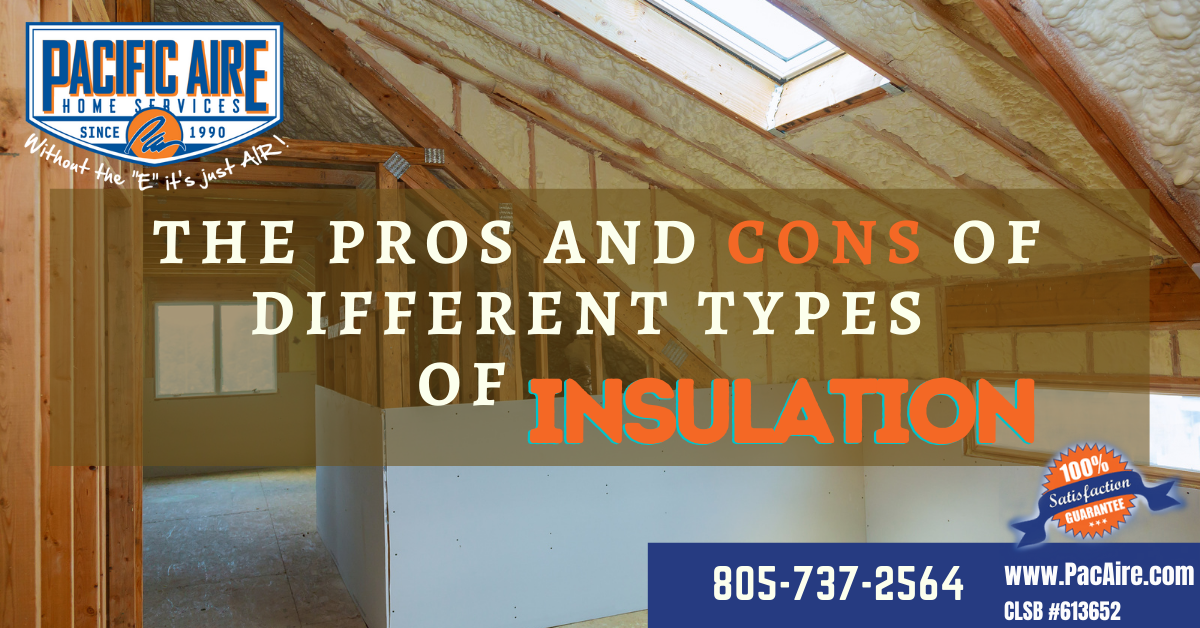Are you considering adding insulation to your home? There are different types of insulation and it plays a significant role in your home improvement. It’s also a part of a comprehensive heating and air conditioning service. Currently, many homeowners are choosing eco-friendly methods of insulating.
The attic is where insulation is done. The outdoor temperature enters through this area. The attic air is mostly filled with dust and pathogens due to the small space and little ventilation. Dirty attic air gets into the home through holes and crevices between the attic deck and the home ceiling. New homes must meet insulation requirements as per California Title 24. This is a requirement that all new homes be fitted with a minimum level of R-30 insulation. The measurement is approximately 10 inches deep. When discussing energy efficiency and budget, insulation pros and cons must be addressed.
The HVAC industry uses many kinds of insulation. Here are the pros and cons of each type.
Radiant barrier insulation
Radiant barrier insulation is one of the most popular types of insulation. This is an insulation where large metal sheets are attached to the underside of the roof. Heat is absorbed between the metal sheets when it enters through the roof.
Pros
- Most effective in hot weather
- No Deterioration over time
- You don’t have to worry about mold growing on it.
Cons
- Less effective in cold climates
- Easily contaminated with dust and dirt
- Neither convection or conduction will be able to prevent heat gain.
Blown Insulation
This is the second most popular option for insulation. In general, it’s made of fiberglass or cellulose, so it works great and is flexible. Its fineness fits any space. It can be applied to existing walls with little damage. Setting up can be an advantage in attics, but the opposite in walls. Retrofit situations are well suited for this solution.
Pros
- Can be re-used by collecting it, using a vacuum and moving it to another area.
- The most affordable choice for a ductwork and it easily fills around pipes.
Cons
- When installed with standard construction methods, “cellulose ceilings” can cause overloading.
- Fiberglass dust can trigger respiratory problems and skin irritations.
- This type of insulation material retains moisture to an extent that it causes mold and performance problems.
Blanket and Batt Insulation
Batt insulation is generally made of fiberglass, cotton or mineral wool. Extra care is needed to fit around pipes and wiring. Compression does not negatively affect performance as commonly believed.
Pros
- Vapor barriers are supported by optional facings.
- Easily installed and affordable
Cons
- Poor installation results in poor performance. (holes, tears, gaps)
- Eyes, lungs and skin can be irritated by glass fibers, which can cause respiratory difficulties.
- Heat can flow through structural elements
Reflective Insulation
Reflective insulation blocks radiant heat transmission as well as heat transfer, unlike spray foam and batts, which block transmission via air convection. Rigid foams can be configured to reduce conduction.
Reflective insulation works like an insulated thermos jug by interrupting heat radiating from undersides of roofs or other places where heat transfer does not require air flow or direct contact.
Pros
- Installs easily; offers vapor barrier
- Designed for warm climates to reflect heat. Wraps pipes and duct work well.
- Neither deteriorates nor compresses like other low-priced insulation materials.
Cons
- Increased dirt build up reduces performance.
- This type of insulation can’t be the only material used in cold weather. It’s usually included in rigid foam as a foil layer.
Spray Foam Insulation
Spray foam generally outperforms any other insulation product. Its primary advantage is that it stops air movement, however, the cost can be an issue. Open cell foam expands to fill any void but provides lower R-value density and can cause moisture leakage. On the other hand, closed-cell foam retains bubble integrity, providing a waterproof, air-tight seal.
Pros
- Removes the need for separate vapor barriers and minimizes sound transmission.
- It can be applied anywhere and has the highest R-value density.
Cons
- Much more costly than other materials.
- Typically needs a subcontractor with specific training and experience.
- Toxic gasses are released during installation. Makes the site untidy. Leakage occurs through leaky joints and openings.
Rigid Foam Insulation
It combines the benefits of ease of installation with efficient performance of foam. There are three main types: expanded polystyrene, extruded polystyrene, and polyisocyanurate. It can achieve spray foam levels of R-value density. All rigid foam is waterproof. Foam sheets are very durable.
Pros
- A mid-priced option between expensive spray foams and affordable blown and batt styles.
- The only product designed to block heat conduction through structures.
- No equipment is required for installation. Workers do not need special protection.
Cons
- For structural elements, rigid foam is not allowed to be used. Often, living spaces must be covered with drywall as well.
- To maintain an air-tight enclosure, it must be shaped to fit around wiring, pipes, and joints, then sealed around all joints and cuts
Pacific Aire Heating & Air Conditioning provides a wide range of HVAC services, including attic insulation.
For any concerns about Attic Insulation, schedule an appointment with our expert HVAC technicians. For any other HVAC servicing needs, visit https://bit.ly/PacAire_attic_insulation or call us at 805-737-2564.


